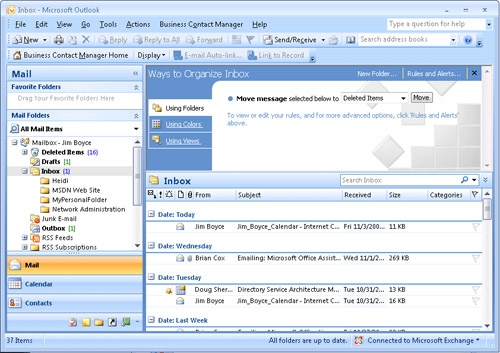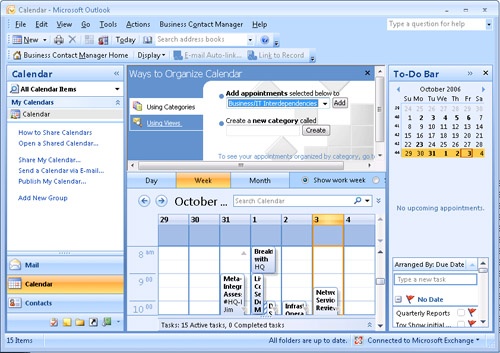Searching for data and organizing data usually go hand in hand. One of the main motivations for organizing your data is that you want to be able to find it easily. Even with perfect organization, however, you’ll still need to perform searches now and then because of the sheer amount of data that might be involved. Outlook 2007 provides several ways to organize your data. Whereas other chapters focus on specific ways to organize your Outlook 2007 items, this section provides an overview of ways you can organize certain types of items and points you to the appropriate chapters for additional information.
E-mail messages probably make up the bulk of your Outlook 2007 data. For that reason, organizing your messages can be a challenge. Outlook 2007 offers several features that will help you organize your messages so that you can find and work with them effectively and efficiently.
Search folders are the best means in Outlook 2007 to quickly organize messages without moving those messages around to different folders. A search folder looks and acts like a folder, but it’s really a special type of view that displays in a virtual folder view all messages that fit the search condition for the search folder. Search folders offer two main benefits: They can search multiple folders, and they organize messages without requiring that the messages be moved from their current folder.
Note
See "Finding and Organizing Messages with Search Folders" in Chapter 10 to learn more about search folders.
Another great way to organize your e-mail messages is to separate them in different folders. For example, if you deal with several projects, consider creating a folder for each project and moving each message to its respective folder. You can create the folders as subfolders of your Inbox or place them elsewhere, depending on your preferences. You might even create a folder outside the Inbox named Projects and then create subfolders for each project under that folder.
Note
For more information about creating and managing folders, see Chapter 30.
Rules are one of the best tools you have in Outlook 2007 for organizing messages. You can apply rules to selectively process messages—moving, deleting, copying, and performing other actions on the messages based on the sender, the recipient, the account, and a host of other message properties. You can use rules in combination with folders to organize your e-mail messages. For example, you might use rules to automatically move messages for specific projects to their respective folders. You can apply rules to messages when they arrive in the Inbox or any time you need to rearrange or organize.
Note
For a detailed discussion of rules, see Chapter 11.
Outlook 2007 uses color categories to help organize your e-mail messages. If you create rules to apply certain color categories to specified e-mail messages, the color can provide a visual indicator of the sender, the subject, the priority, or other properties of the message. In this way, you can see at a glance whether a particular message meets certain criteria. You can also use automatic formatting in a view to apply color categories.
Note
For more information about color categories, see Chapter 5.
Views give you another important way to organize your Outlook 2007 data. The default views organize specific folders using the most common criteria. You can customize Outlook Today view using HTML to provide different or additional levels of organization. You can also create custom views of any Outlook 2007 folder to organize your data to suit your preferences.
Note
For more information about customizing views, see "Customizing Outlook Today View" in Chapter 26 and "Creating and Using Custom Views" in Chapter 27.
You can organize your Inbox and other folders manually, or you can use the Organize pane, which gives you quick access to some of the organizational features that Outlook 2007 provides. Open a folder, and then choose Tools, Organize to view the Organize pane, shown in Figure 33-13. Using this feature to organize your e-mail folders is relatively easy.
The Organize pane gives you four options for organizing the current folder. Clicking the link for a particular option changes the options displayed in the Organize pane. The following list describes the types of actions that you can perform with each option (not all options appear in every folder):
Using Folders. Moves selected messages to other folders.
Using Colors. Colors messages sent to or from an individual. You can also specify that messages sent only to you be displayed in a specific color.
Using Categories. Adds categories to selected items and creates new categories.
Using Views. Selects from several predefined views.
Note
You’ll find additional information about the Organize pane in "Using the Organize Pane to Create Rules" in Chapter 11.
You can use the Organize pane in your Calendar folder, as shown in Figure 33-14, to organize items in your calendar.
Figure 33-14. Use the Organize pane in the Calendar folder to apply categories to calendar items and select a view.
To assign categories to calendar items, click the Using Categories link. Select the items, select the category you want in the drop-down list, and then click Add. You can also use the Organize pane to create a category.
Note
For a detailed discussion of categories, including how to share categories with others, see Chapter 5.
You can change the calendar view from the Organize pane, which allows you to switch to a view that organizes your data the way you want. To change your view, click the Using Views link in the Organize pane, and then select an existing view in the list. (This is the same as choosing View, Current View, followed by the view you want to use. Changing the view this way, however, closes the Organize pane, whereas choosing the option in the Organize pane does not.)
Like your other Outlook 2007 folders, the Contacts, Tasks, and Notes folders have an Organize pane that you can use to organize your contacts, tasks, and notes. The Organize pane gives you three options for organizing contacts and tasks:
Using Folders. Use this option to move selected items to another folder, which you can select from a drop-down list in the Organize pane (refer to Figure 33-13).
Using Categories. Click this link to assign selected items to one or more categories and create new categories.
Using Views. Click this link to select a view. This is the same as choosing View, Current View, followed by the view you want to use, but unlike that method, this link leaves the Organize pane open.
The Notes folder provides only the Using Folders and Using Views options and does not let you specify categories in its Organize pane. You can assign categories to a note, however, by right-clicking the note and then choosing Categorize.


